The phrase characterized a phenomenon found in evolutionary biology. A population is caught in a dead end; its niche is contracting and the species is so well adapted to that niche that it cannot survive elsewhere. How can the population survive? One thing that happens is that subsequent generations become dedifferentiated, simpler if you will (“dropping back...”), which allows them to move to a new niche (“... and punting”), and there the population can develop new specializations appropriate to that niche. Koestler saw certain forms of (cultural) creativity as functioning like that. (Bleg: Does anyone know the French term that Koestler used?)
That’s what graff culture is up to, which puts us in territory I explored in a recent post, Through Duchamp and Beyond: Graffiti in the Promised Land?, and a somewhat older one, Graffiti Hit the Reset Button on Culture. As we know, graffiti started totally outside the art world. It was made by people who simply wanted to put a claim on the world, to be recognized. They weren’t interested in making art; that came later, and fitfully.
As Susan Farrell, founder of Art Crimes, put it to me in email, graffiti is a combination of art and extreme sport. Take this example by Distort:
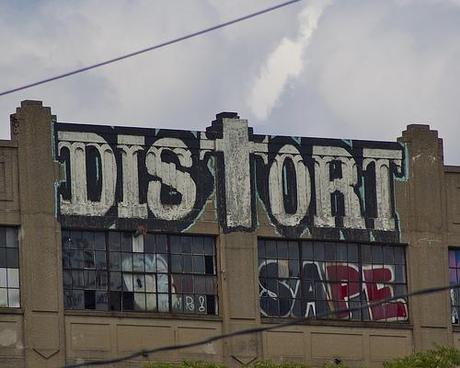
While it has a certain style, it is not Art in any conventional sense. What’s remarkable is that it’s at the top of an abandoned five or six story building.
Just around the corner you can see this:
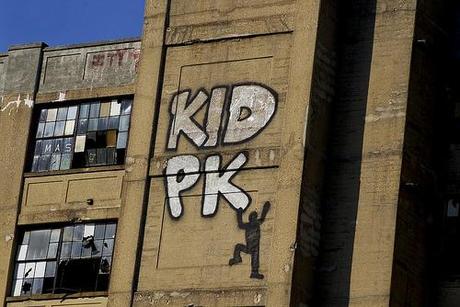
It states the issue rather nicely: How the hell did they DO that?
That’s the extreme sport aspect of graffiti. However THEY did it, it took a combination of bravado and athleticism. There was physical challenge and danger involved. The Mona Lisa it ain’t, but could YOU get up there and do anything at all? No, you couldn’t. End of story.
The danger and challenge gets the juices going. It’s a thrill and a pleasure to get up there and do that. That thrill and pleasure blurs over into something Eric Fischl, a “legit” artist, told me about in conversation at a party. When the creativity is flowing and your brush can do no wrong, you’re in a “hot studio.” In one case it’s physical danger that puts you in an elevated state of mind; in the other case, it’s the artistic process itself.
And then there’s pieces like this, another one by Distort:
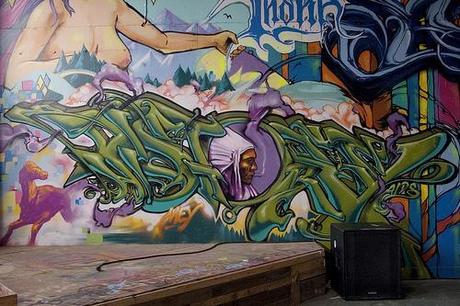
Here we see conventional artistic skill at work. There’s a realistically rendered horse at the lower left and an Indian in the middle (he’s probably smoking some kinda’ wacky weed). As for the green vermiculated work, it’s a name, “Distort”, rendered in so-called wild style. Anyone who’s more than glanced at illuminated manuscripts or Arabic calligraphy recognizes the geometric intricacy of the letters. It took several years for graffiti to evolve from ordinary letterforms, placed often enough in remote places, to wild-style intricacy.
At the same time graffiti writers began incorporating representational imagery, often in the form of cartoon characters. Here’s a recent example:
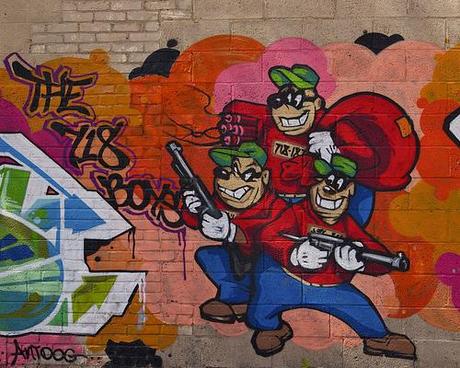
From there it’s but a short step to the more realistic style of that horse and that Indian, or this snake’s head
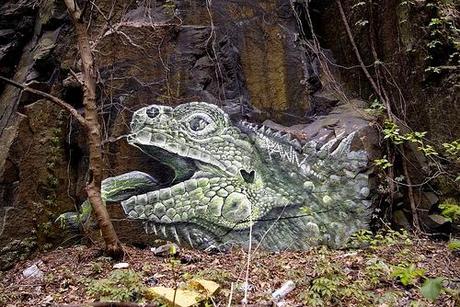
or this portrait of Salvador Dali (both by Pawn):
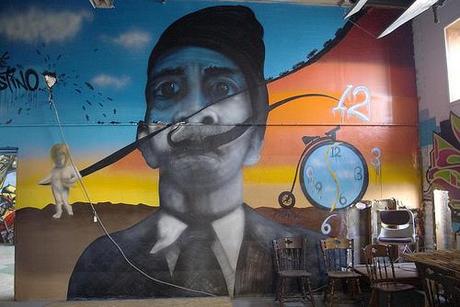
* * * * *
My point, then, is that Western art had boxed itself into a corner by the third quarter of the previous century. All that’s going on is recycling old styles within old motifs covered over by old philosophical arguments (now recycled as artist’s statements). It’s a con, but what else can we do?
I’m suggesting that graffiti may be a vehicle through which we find ways out of this cultural dead end. In many ways it’s primitive and elemental and, as Susan Farrell noted, at times it’s intertwined with brute physical adventure. And THAT may well be one of graffiti’s strengths, it refuses to disconnect from the body, it refuses to surrender to the arid cerebrality of so much recent “art”.
At the same time, as I’ve argued in Graffiti Aesthetics: The Space of Writing, it may well have a fundamentally new conception of aesthetic space. Graffiti’s central commitment is to the name, and the name is but a line, variously twisted, folded, and broken. That line is not at all the 3D perspective space that entered Western art during the Renaissance and dominated it from then until the end of the 19th Century. Nor is it like any of the spaces (cubist, surreal, early 20th C. abstraction) or non-spaces (think of the abstract expressionists) that have dominated 20th Century art. It is something different, and perhaps, just perhaps, it is or can be the foundation of new aesthetic regimes.
Only time will tell. But, it will tell us rather quickly, no more than a decade or two more.

